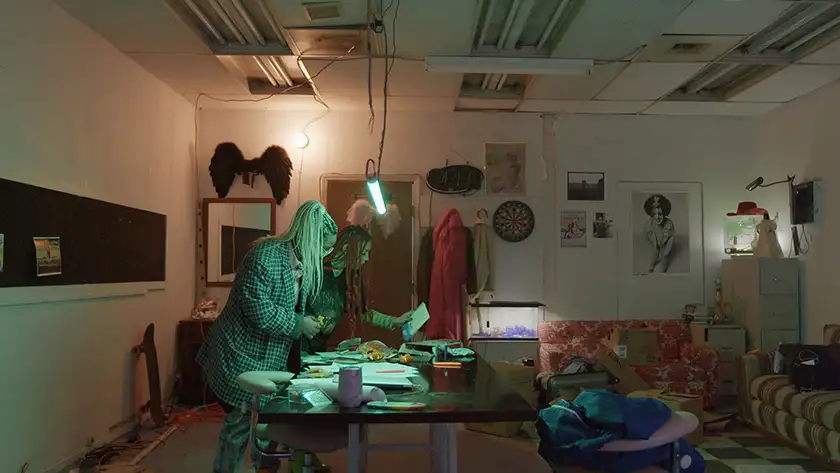Debut filmmaker Jazmin Jones’ documentary Seeking Mavis Beacon seeks to explore the real person behind Mavis, Renée L’Espérance.
Seeking Mavis Beacon is the directorial debut from Jazmin Jones and partial brainchild with Olivia McKayla Ross. The documentary premiered at the 2024 Sundance Film Festival and is about to be screened at the True/False Film Festival. Existing at the intersection of culture, feminism, and technological legacy, the movie explores the history of the woman who was the face of an iconic piece of software, along with a broader message about consent and the filmmakers themselves. Though it touches upon themes and deeper conversations worth having, Seeking Mavis Beacon suffers when it strays from its point and ventures down digital rabbit holes.
The central thesis of the movie surrounds finding the Black icon and computer typing legend Mavis Beacon. For those unfamiliar with Beacon, she was the “imaginary” typing teacher from the titular Mavis Beacon Teaches Typing software programs, designed to teach touch typing through interactive games and lessons, from the late 1980s through today. Although Mavis Beacon herself wasn’t real, the cover model was a real person. Mavis Beacon was a household name in the United States, but the woman behind the name was a bit of a mystery. The documentary delivers on the promise of unraveling the mystery, but getting there takes a long, winding road filled with bright colors and conspiracy theories disguised as intuition. This is less a documentary about Mavis Beacon and more an exploration of filmmaker Jazmin Jones and her relationship with the internet of days past.
Seeking Mavis Beacon proposes several bold ideas about the tech industry and its exploitation and dehumanization of Black women. As a society, this cultural reckoning is past due and a conversation worth exploring given today’s tech robber barons that dominate the “World’s Richest Lists” and the cultural reverence we hold for Silicon Valley and mythical tech origin stories. If you were pitching this documentary to jaded execs asking you the dreaded “Why you? Why now?,” that’s your answer.
In the documentary, typing icon Mavis Beacon is likened to a tech Aunt Jemima. Instead of being a pancake spokeswoman-based racial stereotype, Mavis Beacon is the woman who taught millions of people worldwide to type. The face on the software box and the face and hands within the software itself, for many people, Beacon is deeply linked to their first computer experiences. As the film points out, she stood out in the sea of software boxes because she was a Black woman. Although it was done for branding purposes and not for morally laudable reasons, this representation allowed many people to trust computers and technology.

The typing software was designed by three guys in a garage (hello, typical Silicon Valley origin story) and was enormously successful. Mavis Beacon was in schools and offices – she was, at times, everywhere. But as the film points out, today, we still don’t have a deep dive into the real person that lent her likeness to the project. As Seeking Mavis Beacon progresses, we find out – through convoluted storytelling that, at times, feels performative and not authentic – that the woman who portrayed Mavis Beacon, Renée L’Espérance, wants to be left alone.
Perhaps that’s why the Jones took the wild and very Gen-Z route to get to the point. Seeking Mavis Beacon is as much a story about what Mavis Beacon is to them as her legacy in Silicon Valley and the world beyond. This documentary is not straight to the point NOVA fare. David Attenborough is not narrating and as the audience, we are participants in this trip. There are moments during it where it approaches Michael Moore-level investigation, but in an effort to amp up the drama, instead of making the case with facts and Lexis Nexis reports, the filmmakers instead present their ideas through the reductive lens of e-girl detectives.
If you grew up during a certain time, there are parts of Seeking Mavis Beacon that touch on nostalgia and novelty. While they scratch the same itch that seeing someone on Instagram talk about Pogs or life in the 90s and early 2000s, much like the vanity vignettes of the film, it isn’t clear that they propel the documentary’s narrative towards its end result and conclusion. There are Easter Eggs upon Easter Eggs buried in the detective wranglings of the women, and if you’re older, those parts of the film will have you wanting to freeze-frame it and remember every small thing from days of tech past.
At its core, Seeking Mavis Beacon is not a story about Mavis but a dizzying vanity story about the filmmakers and their relationship with computers and the internet. It falls apart when it strays from Seeking Mavis and what Mavis is and from the tenets of glitch feminism. The glacial pacing and frequent side quests made it so that during the film, I just wanted the filmmakers to hurry up and get on with and get to the interesting and thought-provoking parts that the audience was promised in exchange for an hour and forty-two minutes of their time. Ultimately, it was a disappointing digital video scrapbook desperately needing an edit. There is a worthwhile message to be had in this film, but it is buried within the bloat.
Seeking Mavis Beacon was screened at the True/False Film Festival on February 29-March 3, 2024 and released in US theaters in August-September 2024. The film is now available to watch on digital platforms in the US and Canada and will be released in UK and Irish cinemas on May 9.
